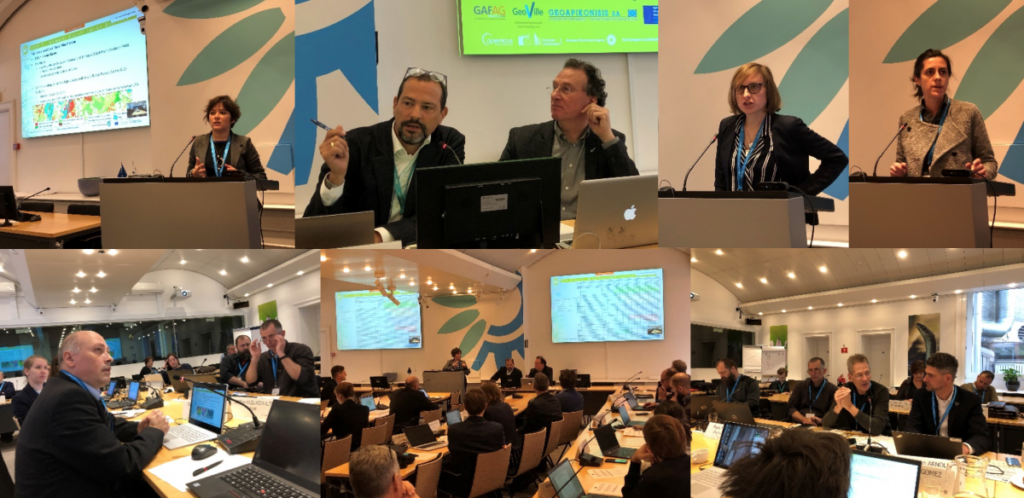A European consortium of 14 companies and research institutions from 11 EEA member countries under the lead of GAF (Germany) has been awarded a 10 million € framework contract for implementing the CLC+ Backbone, the new ground-breaking standard in Copernicus Land Monitoring. This unique product will constitute a key element in monitoring the European Green Deal and strengthen Europe’s position as a global leader in tackling climate change issues.
“I’ve been waiting for this day very long”, said Chris Steenmans, Head of Programme for Data and Information Services at the European Environment Agency (EEA), when he described his expectations in front of the 35 experts assembled at the EEA on 27th/28th February 2020, for kicking off the first stage of the CORINE Land Cover (CLC) second generation: The CLC+ Backbone. This latest product of the Copernicus Land Monitoring Service (CLMS) family is meant to “set the scene in Copernicus for the coming decade”, added Hans Dufourmont, Coordinator of the CLMS team at the EEA.
The recently signed 10 million € CLC+ Backbone framework contract is the largest and most complex one awarded by the EEA so far. It will be implemented by a truly European team of companies and research institutions from 11 EEA member countries: Under the lead of GAF (Germany), the consortium of GeoVille (Austria), Geoapikonisis (Greece), Ingénierie Géographique Numérique Française à l’International (France) and e-GEOS (Italy), together with IABG (Germany), Z_GIS (Austria), DHI GRAS (Denmark), Telespazio Ibérica (Spain), the National Land Survey of Iceland (Iceland), Terranea (Germany), Oikon (Croatia), Geosystems Polska (Poland) and DKM (Turkey), represents a unique blend of some of the most experienced companies in land cover and land use monitoring in Europe and an exceptional CLMS production heritage.

The 2-day meeting in Copenhagen was supported by experts of the European Topic Centre on Urban, Land and Soil Systems (ETC ULS) and the Environment Information and Observation Network (EIONET) Action Group on Land monitoring in Europe (EAGLE), which is an assembly of National Reference Centres and national experts on Land Cover from the 38 EEA member and cooperating countries.
Building on the rich legacy of more than 30 years of CORINE Land Cover and the unique success story of user uptake all across Europe, the upcoming CLC+ product suite will bring a true paradigm change in land cover/land use monitoring. In particular, it will enable to largely overcome shortcomings of the ‘traditional’ CLC approach with 25 ha minimum mapping unit, notably in terms of information granularity and ‘mixed’ land cover constituents in the same objects.
The CLC+ Backbone, as first component of the new CLC+ era, will feature an object-oriented wall-to-wall high-resolution inventory of European land cover and its characteristics in unprecedented quality and detail, for the reference year 2018. It will comprise a pan-European segmentation of vector-based stable landscape objects and a raster-based classification of 12 EAGLE compliant land cover components from fully integrated optical/radar time series of Sentinel-1/-2 satellite imagery. In a next step, both datasets will be fused into a fully attributed 18 land cover class vector product with 0.5 ha minimum mapping unit, incorporating a multitude of further information layers derived from satellite data and various other Copernicus products. Cutting-edge data processing technology, together with a portable state-of-the-art cloud computing environment, will ensure meeting the high product quality and timeliness requirements.
The CLC+ Backbone products will allow serving many current and future needs in European land cover/land use monitoring and policy reporting, as well as paving the way for all follow-up CLC+ components. Together with land use information from the EEA-38 countries plus UK, the CLC+ Backbone land cover products are foreseen to be ingested into the upcoming CLC+ Core Database, which will enable deriving various so-called CLC+ Instances, such as for LULUCF reporting and for ensuring a ‘traditional’ CLC Legacy product for time series continuity of the traditional CLC into the future.



